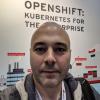It's been just over three years since Solomon Hykes presented the world with the (so far) most creative way to use the tar command: the Docker project. Not only does the project combine existing container-technologies and make them easier to use, but its well-timed introduction drove an unprecedented rate of adoption for new technology.
Did people run containers before the Docker project? Yes, but it was harder to do so. The broader community was favoring LXC, and Red Hat was working on a libvirt-based model for Red Hat Enterprise Linux. With OpenShift 2, Red Hat had already been running containers in production for several years - both in an online PaaS as well as on-premise for enterprise customers. The model pre-Docker however was fundamentally different from what we are seeing today: rather than enabling completely independent runtimes inside the containers, the approach in
OpenShift 2 and libvirt-lxc was to partition the host, re-using the software installed on the host-machine. There were several issues with this model, however, with the most prominent being complexity. Modern deployments are so complex that the process of recreating an application stack (from a puppet manifest, for example) over and over again in dev / test / ops has become too fragile.
This mirrors the problem that we faced with the predominant operational model roughly 20 years ago, when we moved from compiling software on local machines to pre-build binary distribution with rpm. The issue we solved in the “olden days” was that the behavior of a locally compiled application was dependent on the state of the machine at build time and the overhead of this model. We needed binary distribution to achieve a predictable experience of the aggregate software stack.
Today, stacks are so complex and changes in software streams so frequent, that the stack you build is neither what you test nor is what you end up running in production; adding on top of this is the demand for updating applications/systems in place. This brings us back to a situation where the behavior of a production software stack simply becomes dependent on too many variables.
So how do containers, specifically the packaging as provided by the Docker project, marginalize if not outright eliminate these variables? By partitioning and aggregating, of course, which leads to a whole other set of challenges and solutions...but that’s for my next post.
저자 소개
Daniel Riek is responsible for driving the technology strategy and facilitating the adoption of Analytics, Machine Learning, and Artificial Intelligence across Red Hat. Focus areas are OpenShift / Kubernetes as a platform for AI, application of AI development and quality process, AI enhanced Operations, enablement for Intelligent Apps.
유사한 검색 결과
채널별 검색
오토메이션
기술, 팀, 인프라를 위한 IT 자동화 최신 동향
인공지능
고객이 어디서나 AI 워크로드를 실행할 수 있도록 지원하는 플랫폼 업데이트
오픈 하이브리드 클라우드
하이브리드 클라우드로 더욱 유연한 미래를 구축하는 방법을 알아보세요
보안
환경과 기술 전반에 걸쳐 리스크를 감소하는 방법에 대한 최신 정보
엣지 컴퓨팅
엣지에서의 운영을 단순화하는 플랫폼 업데이트
인프라
세계적으로 인정받은 기업용 Linux 플랫폼에 대한 최신 정보
애플리케이션
복잡한 애플리케이션에 대한 솔루션 더 보기
오리지널 쇼
엔터프라이즈 기술 분야의 제작자와 리더가 전하는 흥미로운 스토리
제품
- Red Hat Enterprise Linux
- Red Hat OpenShift Enterprise
- Red Hat Ansible Automation Platform
- 클라우드 서비스
- 모든 제품 보기
툴
체험, 구매 & 영업
커뮤니케이션
Red Hat 소개
Red Hat은 Linux, 클라우드, 컨테이너, 쿠버네티스 등을 포함한 글로벌 엔터프라이즈 오픈소스 솔루션 공급업체입니다. Red Hat은 코어 데이터센터에서 네트워크 엣지에 이르기까지 다양한 플랫폼과 환경에서 기업의 업무 편의성을 높여 주는 강화된 기능의 솔루션을 제공합니다.

